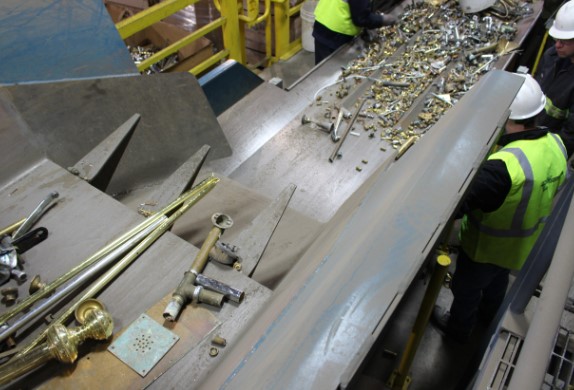How is Scrap Metal Processed?
Scrap metal recycling is an an important part of the modern metal recycling process, transforming discarded scrap materials into valuable raw materials for new metal products. This process conserves natural resources, saves energy, and reduces environmental impact. In this comprehensive guide, we will explore the various stages of the scrap metal recycling process, detailing each step and its significance.
Below is the TL;DR version in table form.
Table of the Scrap Metal Recycling Process
| Step | Description |
|---|---|
| Collection | Gathering scrap metal from various sources |
| Sorting and Separation | Categorizing and separating metals based on type and properties |
| Processing and Shredding | Breaking down large metal pieces into smaller, manageable fragments |
| Melting and Purification | Converting scrap metal into liquid form and removing impurities |
| Formation of New Products | Shaping and manufacturing new metal products from recycled metal |
| Transport and Distribution | Moving processed metal to manufacturers and markets |
| Environmental and Economic Impact | Assessing the benefits of recycling on the environment and economy |
Introduction
Scrap metal recycling involves the recycling process of converting discarded scrap materials into new, usable metal products. This practice has significant environmental benefits, such as conserving natural resources and reducing air pollution. By recycling metal, industries can minimize the need for new raw materials and lower their energy consumption.
Collection of Scrap Metal
The collection process is the first step in the scrap metal recycling process. Scrap metal can be sourced from various places, including households, businesses, construction sites, cars and vehicles, and scrap yards. Common sources include construction and plumbing scrap, old vehicles, household appliances, and farm scrap. Collecting scrap metals efficiently is crucial for the success of the entire recycling process.
Sources of Scrap Metal
- Construction and Plumbing Scrap: Pipes, fixtures, and fittings.
- Household Appliances: Refrigerators, washing machines, and ovens.
- Vehicles: Cars, trucks, and buses.
- Farm Scrap: Old machinery and tools.
Sorting and Separation
Once collected, the scrap metals must be sorted and separated to ensure efficient recycling. This step involves categorising metals into ferrous and non-ferrous metals. Ferrous metals contain iron and are magnetic, while non-ferrous metals do not contain iron and have higher resistance to corrosion. Common non-ferrous metals include aluminum, copper, and brass.
Techniques for Sorting and Separation
- Magnetic Properties: Using magnets to separate magnetic iron containing metals from nonferrous scrap.
- Hydraulic Machinery: Utilizing powerful machinery to crush and separate metals.
- Conveyor Belt: Sorting metals as they move along a conveyor system.
- Large Magnetic Sensors: Detecting and sorting metals based on their magnetic properties.

Image source: https://www.generalkinematics.com/product/scrap-sorting-system/
Processing and Shredding
After sorting, the scrap metal is processed and shredded into smaller pieces. This step is essential for preparing the metal for melting. Shredders, such as hammer mills, break down large metal items into fragments, making it easier to handle and melt. The shredded metal is then cleaned to remove any non-metallic contaminants like plastic or paint.
Machinery Used in Processing and Shredding
- Hammer Mills: Heavy-duty machines that shred metal into smaller pieces.
- Conveyor Belts: Transporting shredded metal to different parts of the recycling facility.
- Hydraulic Machinery: Compressing and compacting metal fragments.
Melting and Purification
The next stage involves melting the shredded scrap metal in large furnaces. Different metals have varying melting points, so they are melted separately in specialized furnaces. The melting process converts the metal into a liquid form, which is then purified to remove any remaining impurities.
Melting and Purification Techniques
- Large Furnaces: Used to melt the metal into a liquid state.
- Cooling Chamber: Cooling the melted metal to form solid metal bars or ingots.
- Purification: Removing impurities to ensure the metal is of high quality.
Formation of New Metal Products
Once purified, the recycled metal is used to manufacture new products. The recycling process ensures that the metal retains its properties, making it suitable for various applications. Recycled steel, aluminum, and copper can be transformed into a wide range of products, from construction materials to consumer goods.
Products Made from Recycled Metal
- Construction Materials: Beams, rods, and sheets.
- Consumer Goods: Cans, appliances, and electronics.
- Automotive Parts: Engine components, frames, and panels.
Environmental and Economic Impact
Recycling scrap metal has profound environmental benefits. It conserves natural resources, reduces energy consumption, and minimizes pollution. For example, recycling aluminum saves up to 95% of the energy required to produce new aluminum from raw materials. Additionally, the economic benefits include job creation and cost savings for manufacturers who use recycled materials.
Environmental and Economic Benefits
- Energy Savings: Using less energy compared to producing new metals from ores.
- Resource Conservation: Reducing the need for mining and extracting new raw materials.
- Pollution Reduction: Lowering emissions and reducing waste.
- Economic Growth: Creating jobs and supporting the recycling industry.
Final Notes
The scrap metal recycling process is a complex but essential part of modern industry. By efficiently collecting, sorting, processing, and melting scrap metal, we can produce high-quality recycled metals that contribute to sustainable manufacturing practices. The environmental and economic benefits of recycling metal are significant, making it a crucial component of a circular economy. Through continued innovation and improvement in recycling techniques, we can ensure that more scrap materials are effectively recycled, reducing our reliance on natural resources and minimizing our environmental footprint.
By following these steps, the scrap metal recycling industry can continue to thrive, providing valuable materials for new products while protecting the environment for future generations.

